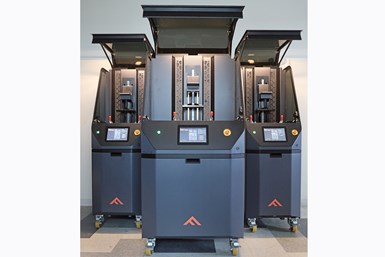Photopolymer Printers, Open Access Software Enable New Applications
The company’s printer versions are tailored for specific-use cases, giving users the power to develop new advanced materials.

Fortify Flux series printers
Fortify, a developer of an advanced filled-photopolymer 3D printing platform, has extended its Flux series product lineup to include new printers and software that enable customers and partners access to develop more end-use part applications.
The company’s printer versions are tailored for specific-use cases, giving users the power to enter new markets. All Fortify 3D printers employ the company’s Continuous Kinetic Mixing (CKM) processing technology, which enables printing of heavily filled photopolymers while maintaining homogeneity. Fortify’s other technology, Fluxprint magnetic alignment, is now available in two configurations.
The Flux Core is Fortify’s baseline 3D printer, which includes CKM and is well suited for processing viscous particle-filled resins where magnetic alignment is not required. Applications include RF devices and electronic applications.
The Flux One was released in 2020 and adds Fluxprint Z (Z-axis magnetic field) to the baseline Core 3D printer. The system overcomes the persistent challenge of Z-axis anisotropy in 3D printing. Applications include robust mold tooling, jigs and fixtures.
The Flux 3D leverages Fluxprint 3D (3-axis magnetic field) to the baseline Core 3D printer, providing users with higher levels of control to align fiber in any axis throughout parts as they are printed. Applications include heat sinks, heat exchangers and high-performance industrial connectors.
Fortify’s Flux Developer is a software platform that can be used on any of the Flux printers. It gives users the ability to push the limits of material properties by opening access to all processing parameters. With this expanded processing window, users can control variables such as exposure time and intensity, material flow, resin temperature and viscosity, and even the build plate mechanics, as they develop and onboard new materials. The company says the Flux Developer is the tool kit users need to test and optimize new materials for targeted applications.
Related Content
-
Bauer Hockey Uses EOS 3D Printed Digital Foam for Customizing Helmets
The new in-store experience, combined with proprietary 3D printing technology, opens the door for personalized hockey products.
-
Hasbro Uses Formlabs 3D Printing Technology to Create Custom Action Figures
Hasbro ushers in a new era of mass customization in consumer entertainment with its Selfie Series figures using 3D printing to manufacture personalized action figures at scale.
-
3D Systems, Klarity Partner to Expand Access to Patient-Matched Radiotherapy Innovations
Klarity has added 3D Systems’ VSP Bolus to its radiotherapy solutions, enabling radiotherapy clinics in the U.S. and Canada to embrace 3D printing technology without investing in costly, time-consuming software.









